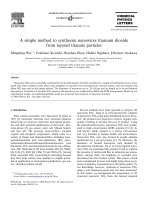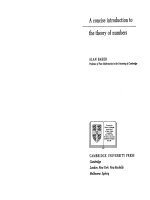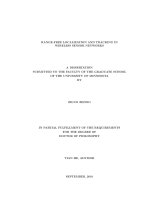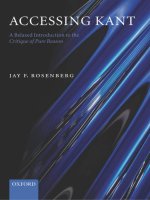A NUMERIC METHOD TO DETERMINE WORKSPACE OF INDUSTRIAL ROBOTS
Bạn đang xem bản rút gọn của tài liệu. Xem và tải ngay bản đầy đủ của tài liệu tại đây (869.7 KB, 6 trang )
Phạm Thành Long và Đtg
Tạp chí KHOA HỌC & CÔNG NGHỆ
139(09): 31 - 36
A NUMERIC METHOD TO DETERMINE WORKSPACE
OF INDUSTRIAL ROBOTS
Pham Thanh Long*, Le Thi Thu Thuy
College of Technology - TNU
SUMMARY
Shape and capacity of robotic workspace are critical information when selecting robot for
particular purpose. This paper presents a numeric method to determine workspace of any dumb
robot. This method is the consequence of the application of GRG algorithm when transforming the
robot kinematic problem into optimization combined with the bisect method. The shape and
capacity of robot workspace resulted from the method in 3D format with adjustable accuracy can
be chosen. This results can be used in robot designing.
Key words: robot workspace, numeric method,grg algorithm, bisect method, robot designing
ROBOT WORKSPACE*
Robot workspace is the movement field of the final activator. This is a continuous space with
particular shape and capacity. The determination of this space is not so difficult in flat or simple
robots. However, in parallel or serial robots with 6 degrees of freedom, the inference is not
simple.
Workspace can be defined in two ways:
- The zone in which the final activator can reach and direct the tool (Type I).
- The pure reachable zone (Type II).
a.
b.
Figure 1.Workspace by compounding the basic geometric shapes for each joint (a) and workspace in front
view 2D (b)
Workspace type II always contains workspace type I as the strict requirements of the Type I
eliminated a large number of points which are not satisfied the tooling orientation. The
description of the two types in detail helps to build boundary conditions to find the shape and size
of workspace.
In fact, in the catalogsprovided by robot manufacturers,workspace type II is presented in front
view and top view without 3D view. In this paper, the determination of both types in 3D view is
presented.
*
Tel: 0947 169291, Email:
31
Phạm Thành Long và Đtg
Tạp chí KHOA HỌC & CÔNG NGHỆ
ALGORITHM TO DETERMINE WORKSPACE
If we use the definition of workspace as the
reachable space of final actuator then the
equivalent technical interpretation is the
inverse kinematic problem which must have
its solution at the point where the final
actuator is reachable. To actualize this, the
following steps need to be done:
- Meshing the whole robot space using such
rule that is easy to investigate and coordinate
points in motion field.
- In each simple investigation line, in both
increase and decrease direction, the boundary
between the root-point and non root-point is
required to point out. The middle point of
these points is considered belong to limit
surface with the fine grid.
- Scanning all points on the edge of
investigating space to show the clear
boundary between workspace and the
remaining.
- With the workspace type II, the condition
for a point pi considered belonging to the
workspace is thekinematic equation at
that point has root.
f (q1 ,..., qn ) pi
qi min qi qi max
(1)
i 1 n
In the equation above, the inequality constraint
presents the mechanical structure condition.
However, the kinematic equation does not
present the orientation of the actuator.
With the workspace type I, mathematical
model has constraints describing the
orientation of the actuator basing on the
particular conditions of the problem. Beside
that, constraints describing mechanical
structure of the robot isstill the natural
constraints.
f (q1 ,..., qm ) pi
qi min qi qi max
q j min q j q j max
i 1 n
j n 1 m
32
(2)
139(09): 31 - 36
The orientation constraints in the model
restricted the workspace. Due to this reason,
the trajectory problems should be simulation
checked before applying on robot as robot
may not be able to move its final actuator
through a hole in the workspace, at which the
Jacobian matrix becomes zero.
To show a point belong to the boundary on
workspace, let look closer to schema in figure 2.
Figure 2. Describing the boundary of workspace
of robot
As can be seen from figure 2, with the
moving orientation through pi-1, pi, pi+1points,
searching space 2d, the problem has root at pi1. Continue searching to point pi+1, the
problem has no root. With d small enough, it
can be approximately considered pi which is a
middle point of pi 1 pi 1 belong to the
boundary of workspace. To increase the
accuracy of the algorithm, the roots of
equation (1) at pi can be checked to determine
either
point
pi 1 pi or pi pi 1 contains
belonging to the boundary of workspace.
The searching result is complete when the
algorithm is completely done in all searching
directions. Set of boundary points describes
the form and space of the workspace.
If the searching mesh is not done at the
beginning, the bisect method can be done as
alternative. Searching process stops when
accuracy conditions of the results are satisfied
equation (3)
(3)
d pi 1 pi
In (3), pi and pi+1 are two points appearing in
consecutive searching round. One of these is
belong to workspace and the other is not,
equivalent to be a root or non-root of equation
(1), respectively.
Phạm Thành Long và Đtg
Tạp chí KHOA HỌC & CÔNG NGHỆ
139(09): 31 - 36
Figure 3. Schema of solution steps
ALGORITHM FOR INVERSE KINEMATIC PROBLEM
As the problem (1) or (2) is solved repeatedly, the effectiveness of the algorithm depends on the
time to solve the problem. In this paper, to conform to the requirements of surveying all kinds of
different robot, we present the numeric method mentioned in [1].
Basis of problem transforming can be presented in figure 4.
base point
O0
A1
A 2 O1
a.
joint spaces
X
ODG
A 3 O2
E
On-1
An
On
T
work space
OV
R
P
tool point
c.
b.
Figure 4. Vectors forming in serial and parallel robots
It can be seen that in terms of modeling principle of the two robot kinds, their kinematic
problems can be described in the same vector form:
A1 A2 ... An .T X .E.R
(4)
Or in algebraic expression:
s x a12
a a
13
x
a y a 23
p x a14
p y a24
p z a34
(5)
This problem can be transformed into an optimization problem
33
Phạm Thành Long và Đtg
Tạp chí KHOA HỌC & CÔNG NGHỆ
139(09): 31 - 36
L f (q1 , q2 ,...qn ) min
qi D;
i 1 n
(6)
The solution of (6) must be the root of (5). Therefore, the objective function of (6) is described as
L (sx a12 )2 (ax a13 )2 (a y a23 )2 ( px a14 )2 ( p y a24 )2 ( pz a34 )2 (7)
Problem (6) is stably solved using GRG algorithm with high accuracy [1]. This method is
suitable for technical problems on a great scale.
NUMERIC SIMULATION
100
430
580
400
125
Considering a robot describing in figure 5, to determine the 3D workspace of this robot, the
following parameters need to be examined:
Three orientation components
650
x4
x3 x2
a12=-(((C
1.C2.C3-C1.S2.S3).C4+S1.S4).C5+(-C1.C2.S3z3
C1.S2.C3).S5).S6+(-(C
.S ).S4+S1.C4).C6
1.C2.C3-C1.S
x52 3
a13= ((C1.C2.C3-C1.S
.S
).C
+S
.S
4
1 4).S5-(-C1.C2.S34 2 3
z4
C1.S2.C3).C5
5
a23=((S
1.C2.C3-S1.S2.S3).C4-C1.S46).S5-(-S1.C2.S3z2
z5
S1.S2.C33).C5
2
Three position
components
x6 1.S4).S5-500.(az140 =500.((C
1.C2.C3-C1.S2.S3).C4+S
1
z6
C1.C2.S3- C1.S2.C3).C5+650.C
.C
1 2.S3+650.C1.S2.C3
x
+125.C1.C2.C3-125.C
1
1.S2.S3+580.C1.C2+160.C1
z1
a24=500.((S
1.C2.C3-S1.S2.S3).C4-C1.S4).S5-500.(S1.C2.S3-S1.S2.C3).C5+650.S1.C2.S3+650.S1.S2.C3
+125.S1.C2.C3-125.S1.S2.S3+580.S1.C2+160.S1
a34=430+500.(S2.C3+C2.S3).C4.S5-500.(x0
160
S2.S3+C2.C3).C
5+650.S2.S3-650.C2.C3+125.S2.C3
+125.C2.S3+580.S2
Figure 5. Robot VR006-CII and its feature kinematic equation set
Figure 6. Boundary conditions for movement when finding workspace of VR006 CII
Meshing the space with grid length of 50 mm, using bisect method to have smaller grids at the
boundary, the results of numeric investigation of workspace type II in top view and front view
are shown in figure 7.
34
Phạm Thành Long và Đtg
Tạp chí KHOA HỌC & CÔNG NGHỆ
139(09): 31 - 36
765
485
1540
523
950
R13
35
R1
43
R3
1360
.3
155
R1
360
1020
50
155
Figure 7. Describing of workspace when connecting points in boundary of robot VR006- CII
Figure 8. Describing of workspace in 3D of robot VR006- CII.
CONCLUSION
The combination of the bisect algorithm and
GRG algorithm makes the determination of
workspace of robot VR006-CII easy and
effective. The expansion of this method into
any dumb robots depends only on the ability
to solve its feature kinematic equation set as
described in (1) or (2). This ability to solve
the set is proved in [1,2].
The algorithm is especially effective when
being applied in parallel robots with high
complexity in structure due to the limitation
in imagination. In this situation, it is difficult
for other methods to find workspace to be
applied.
The method is especially suitable to construct
3D workspace. Therefore this method can be
used as a critical part in designing and testing
robot before manufacturing or operating.
REFERENCES
1. Pham Thanh Long, A New Method to Solve the
Reverse Kinematic Robot Problem, ISTS
Swissotel Le Concorde, Bangkok Thailand, pp.
43-46, November 21-24/2012.
2 Li Wei Guang, TrangThanhTrung, Pham Thanh
Long, A New Method to Solve the Kinematic
Problem of Parallel Robots Using an Equivalent
Structure,
International
Conference
on
Mechatronics and Automation Science (ICMAS
2015) Paris, France, April 13 - 14, 2015.
35
Phạm Thành Long và Đtg
Tạp chí KHOA HỌC & CÔNG NGHỆ
3 Gosselin, C., 1990, “ Determination of the
Works pace of 6 –DOF Parallel Manipulators,”
ASMEJ. Mech. Des.,112,pp.331–336.
4 Merlet, J. P., 1999, “Determination of 6D
Workspaces of Gough-Type Parallel Manipulator
and Comparison Between Different Geometries,”
Int. J. Robot. Res.,189, pp. 902–916.
139(09): 31 - 36
5 Pernkopf, F., and Husty, M., 2006, “Workspace
Analysis
of
Stewart–GoughType
Parallel
Manipulators,” Proc. Inst. Mech. Eng., Part C: J.
Mech. Eng. Sci., 2207, pp. 1019–1032.
6 Merlet, J. P., 1994, “Trajectory Verification in
the Workspace for Parallel Manipulator,” Int. J.
Robot. Res., 134 , pp. 326–333.
TÓM TẮT
MỘT PHƯƠNG PHÁP SỐ XÁC ĐỊNH VÙNG LÀM VIỆC
CỦA ROBOT CÔNG NGHIỆP
Phạm Thành Long*, Lê Thị Thu Thủy
Trường Đại học Kỹ thuật Công nghiệp – ĐH Thái Nguyên
Hình dáng và thể tích vùng làm việc của robot là thông tin quan trọng khi lựa chọn ứng dụng vào
các mục đích cụ thể. Bài báo này giới thiệu một phương pháp số, giúp xác định vùng làm việc của
bất kỳ robot nào không tự hành. Phương pháp giới thiệu ở đây là hệ quả của việc ứng dụng
phương pháp General Reduce Gradient khi chuyển bài toán động học robot sang hình thức tối ưu
kết hợp với phương pháp chia đôi. Kết quả đạt được là hình dáng và kích thước vùng làm việc của
robot dưới dạng 3D với độ chính xác tùy chỉnh bởi người giải. Kết quả của bài toán này có thể ứng
dụng vào quá trình thiết kế robot nói chung.
Từ khóa: vùng làm việc của robot, phương pháp số, thuật toáng rg, phương pháp chia đôi, thiết
kế robot
Ngày nhận bài:20/6/2015; Ngày phản biện:06/7/2015; Ngày duyệt đăng: 30/7/2015
Phản biện khoa học: PGS.TS Nguyễn Văn Dự - Trường Đại học Kỹ thuật Công nghiệp - ĐHTN
*
Tel: 0947 169291, Email:
36









